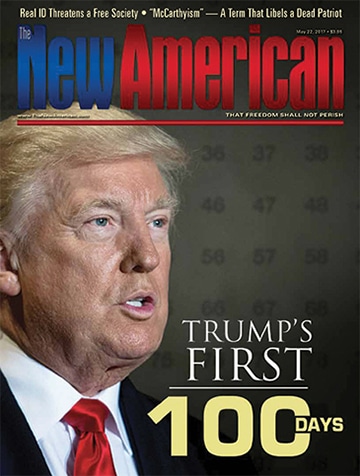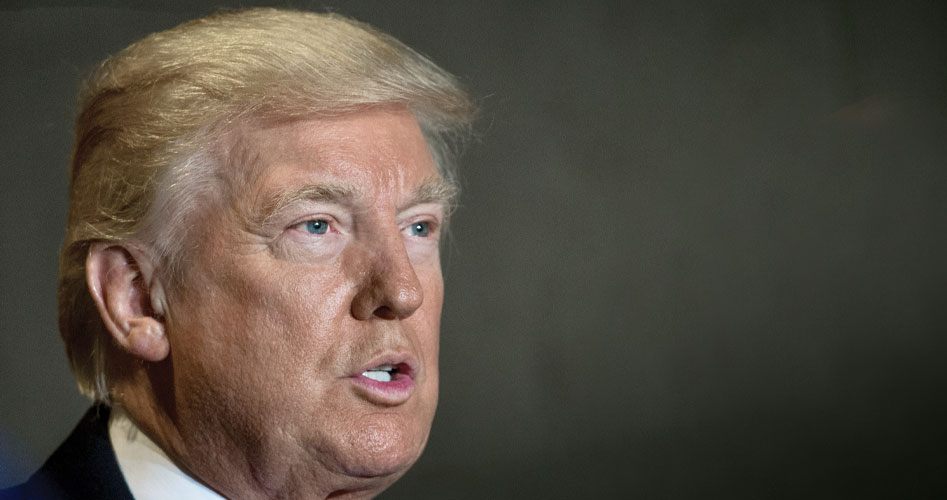Trump’s First 100 Days
Before his term in office started, no one could say for certain what the tempestuous Donald Trump would actually do. To the surprise of many, he has begun keeping his promises.
Within hours of his electoral victory on November 8, President-elect Donald Trump’s many bitter enemies in the politics and the establishment media were vowing to destroy his presidency before it ever got off the ground. Determined to deny Trump the usual “honeymoon period” traditionally accorded to new presidents of both parties, opponents of the brash businessman-turned-politician, including the many servile admirers of his electoral rival, Hillary Clinton, launched a vicious campaign to delegitimize the new president and his “deplorable” supporters. Angry mobs attacked Trump supporters, and hysterical leftists in the media concocted conspiracy theories of Russian complicity. Typical of the unreasoned venom leveled at Trump and his support base was a Tweet from liberal journalist Keith Olbermann, who Tweeted on December 15, “You treacherous Russian whore @realDonaldTrump the White House and all of us have been after you for this for months. And we will get you.”
Never in modern American history has the losing side of a presidential election been so determined from the get-go to destroy an elected president. Every scintilla of Trump’s agenda so far, including his every nominee to every Cabinet position, has been bitterly opposed by the Schumer-led Democrats in the Senate. Every word uttered, Tweeted, or written by President Trump has been parsed by his enemies and set forth as evidence of his utter incompetence to occupy the Oval Office. Even his wife and children have been mocked and derided by the liberal Washington establishment. Efforts to impeach President Trump are already under way, although they are not likely to get much traction in a Republican-dominated Congress.
For his part, President Trump, by ignoring the conventions of Delphic political discourse, has given his enemies plenty of rhetorical fodder. But looking beyond the wild rhetoric and the blizzard of baseless accusations that have disfigured one of the most tumultuous 100 days ever to kick off a U.S. presidential administration, it’s time to take sober-minded stock of Donald Trump’s presidency.
Promises Kept
From the standpoint of conservatives and supporters of limited constitutional government, the first few days of the new Trump administration were heady times indeed. In his inaugural address, Trump put Washington elites on notice that the people were once again in charge of the federal government, not special interests, and promised “a new vision,” assuring the electorate that “from this moment on, it’s going to be America first.” As Trump is doubtless aware, the slogan “America First,” a mainstay of his unconventional campaign, has not been uttered by a serious presidential candidate since before World War II. The “America First” movement, led by the likes of hero aviator Charles Lindbergh, sought to keep America out of World War II, and, had it survived, would doubtless have opposed American membership in the United Nations. But after the Pearl Harbor attack, the America First movement fell apart, and the slogan has been anathema to internationalist elites ever since.
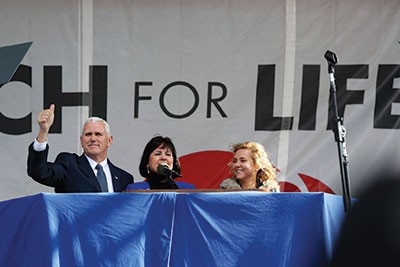
Thumbs up: Vice President Mike Pence at the January 27 March for Life in Washington. The Trump administration has been strongly supportive of the right to life, and Pence’s appearance at the march was the first time a sitting VP addressed the annual event. Pence is also the highest-ranking government official ever to appear at the march. (Photo credit: AP Images)
True to his campaign promises, Trump immediately set pen to paper on his first day in office, directing federal agencies to “take all actions consistent with law to minimize the unwarranted economic and regulatory burdens of the [Affordable Care] Act, and prepare to afford the States more flexibility and control to create a more free and open healthcare market.” Although Congress has yet to put forth legislation in support of Trump’s promise to repeal and replace ObamaCare, the president has exercised such executive authority as he possesses to limit further damage inflicted by this atrocious entitlement program on the American economy and body politic.
On the fourth day of his presidency, Trump reinstated the “Mexico City policy,” which bans federal money from being given to foreign nongovernmental organizations (NGOs) that support or perform abortions. And in a move that cheered small-government advocates everywhere, Trump ordered a hiring freeze across the board in the executive branch.
That same day, President Trump kept another campaign promise by withdrawing the United States from the TPP (Trans-Pacific Partnership), a NAFTA-like international trade regime designed to further erode American economic sovereignty by subjecting our country to another regional trade authority encompassing nations around the Pacific Rim.
Nor is the TPP the only international agreement in President Trump’s sights. On the campaign trail, Candidate Trump was a harsh critic of the 1995 NAFTA agreement, which he vowed to renegotiate to secure more favorable terms for the United States. But more recently, President Trump — to the dismay of the internationalist elites — appears to have hardened his position, and is now talking seriously about taking a page out of Brexit and withdrawing altogether from the sovereignty-sapping organization. According to a new article at Politico.com, Trump is now considering issuing an executive order invoking NAFTA’s withdrawal mechanism. “The executive order [to withdraw from NAFTA] was submitted this week to the staff secretary for the final stages of review,” reported Politico.com. “The draft executive order could be a hardball negotiating tactic designed to bring Mexico and Canada to the table to renegotiate NAFTA. But once Trump sets the withdrawal process in motion,” Politico.com fretted, “the prospects for the U.S. pulling out of one of the largest trade deals on the globe become very real.”
As of this writing, the Trump administration has announced its intent to renegotiate NAFTA with both Canada and Mexico, with President Trump expressing optimism that both countries will be willing to hammer out a new agreement. He then announced that, after talking with both Canadian Prime Minister Justin Trudeau and Mexican President Peña Nieto, both of whom had urged him to keep America in the pact, he had agreed to renegotiate the pact to get a better deal for American workers. Given that the Trump administration recently slapped a tariff on Canadian softwood lumber, however, our neighbors to the north may be in a less-than-conciliatory mood. Stay tuned.
The day after withdrawing the United States from the TPP, President Trump revived the moribund Keystone XL international pipeline project designed to transport volumes of Canadian crude oil from the tar sands of northern Alberta to refineries on the Gulf Coast. This project, long promoted by Canada and pro-business interests in the United States, would greatly enhance American access to oil produced by our neighbor, ally, friend, and largest trading partner, Canada, and reduce our dependence on oil from the volatile and increasingly anti-American Middle East (as well as from increasingly unstable regimes elsewhere, such as Venezuela and Nigeria).
Securing the Borders
On the sixth day of his administration, President Trump turned his attention to another of his most conspicuous and controversial campaign promises, that he would take steps to end illegal immigration by building a wall on the border with Mexico, impose a moratorium on immigration from areas of the world known to be sources of terrorist ferment, and end the practice of shielding illegal immigrants from federal law enforcement by “sanctuary cities.” All of these agenda items, we should note, lie well within the president’s constitutional and legal executive prerogative to defend the borders of the United States. Accordingly, on Wednesday, January 25, President Trump issued an order directing the executive branch to “immediately plan, design, and construct a physical wall along the southern border” and terminating the Obama administration’s “catch and release” policy for illegal immigrants apprehended by federal agents. In a separate executive order issued the same day, Trump ordered federal grants to be withheld from cities and states that refuse to enforce U.S. immigration law, including especially “sanctuary cities” that openly defy federal agents in affording sanctuary to illegal immigrants — including some immigrants with serious criminal records.

Travel ban: President Trump’s temporary travel bans, which would have barred people such as this Iraqi family from entering the United States for 120 days, have been a source of major controversy and have been overruled by the courts. (Photo credit: AP Images)
Two days later, Trump issued an executive order (13769) suspending the entry of foreign nationals into the United States from seven “countries of particular concern”: Iran, Iraq, Somalia, Libya, Sudan, Yemen, and Syria. For the first six countries, the suspension was to be in effect for 90 days, but for Syria, the suspension was to last indefinitely. Furthermore, the order suspended for 120 days the U.S. Refugee Admissions Program. According to the text of the order:
Numerous foreign-born individuals have been convicted or implicated in terrorism-related crimes since September 11, 2001, including foreign nationals who entered the United States after receiving visitor, student, or employment visas, or who entered through the United States refugee resettlement program. Deteriorating conditions in certain countries due to war, strife, disaster, and civil unrest increase the likelihood that terrorists will use any means possible to enter the United States.... In order to protect Americans, the United States must ensure that those admitted to this country do not bear hostile attitudes toward it and its founding principles. The United States cannot, and should not, admit those who do not support the Constitution, or those who would place violent ideologies over American law.
Unfortunately, the Trump administration has met with stiff institutional resistance to all of his immigration-control policies. This has come about especially courtesy of a federal judiciary now dominated by radical leftist judges determined to perpetuate the American Left’s long and shameful legacy of encouraging porous borders. For decades, waves of illegal immigrants have swollen the rolls of government welfare dependents — and the reliably Democratic Hispanic voter bloc.
Having failed to defeat Trump’s populist movement at the polls, the ostensibly pro-democracy Left has now rolled out a decidedly non-democratic strategy for opposing key aspects of Trump’s agenda, both of which have been deployed against the president’s new immigration policies: 1) Dispatch obstreperous and often violent mobs to harass and intimidate Trump supporters and even government officials attempting to implement policies they oppose, and 2) initiate lawsuits in the jurisdictions of dependably radical leftist judges such as those who make up the far West’s infamous Ninth Circuit Court of Appeals. When President Trump’s moratorium on immigrants from certain countries was rolled out, furious mobs descended on major international airports to harass officials and disrupt business in any way possible, frothing at the mouth about “equal rights” and “discrimination” — as if these constitutional issues have any bearing whatsoever on non-citizens of the United States seeking entry from abroad. The actions of these mobocrats attracted enormous attention in the decidedly anti-Trump establishment media, who did their part in trying to portray the curtailment of immigration from areas such as Syria and Yemen as affronts to America’s long tradition of compassion for refugees and solicitude for human rights.
On January 30, just three days after Executive Order 13769 was issued, the state of Washington filed suit against the Trump administration and requested a restraining order. On February 3, a liberal Washington judge, James L. Robart, granted the order, prohibiting the Trump administration from enforcing the order nationwide — to the jubilation of Trump’s enemies. Undeterred, the Trump administration then requested an emergency stay of the order pending appeal, but only six days later, the Ninth Circuit Court of Appeals upheld the judge’s order by a unanimous vote.
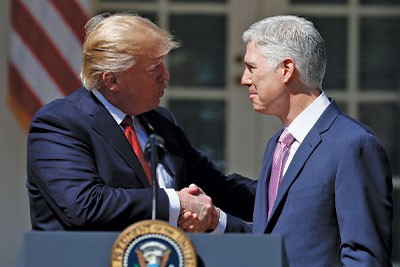
Supremely qualified: President Trump with Neil Gorsuch, America’s newest Supreme Court justice. All but Trump’s most determined enemies agree that Gorsuch is enormously qualified to serve on the court. Gorsuch will likely plow the same originalist furrow as Antonin Scalia. (Photo credit: AP Images)
The Trump administration then issued a revised executive order (13780) that appeared to address the judge’s shaky reservations about the original order. The revised order, issued on March 6, explicitly revoked and replaced 13769. But within a few days, another judge, Derrick Watson of Hawaii, issued another temporary restraining order preventing the Trump administration from enforcing the key provisions of 13780. This time, judicial reasoning was even more tortured, opining that the order was probably motivated by anti-Muslim sentiment, and therefore violated the Establishment Clause of the First Amendment. Watson, it is worth noting, is an Obama appointment to the federal bench with an extensive legal résumé of involvement in celebrated leftist causes. As a young lawyer, for example, Watson worked extensively on cases involving environmental cost recovery and product liability litigation, both causes near and dear to the Left.
More recently, Trump has seen a restraining order suspending his attempt to withhold federal funding from sanctuary cities. In other words, the liberal courts, desperate to stop President Trump’s agenda, have somehow found legal grounds to justify the continued flow of federal taxpayer dollars (mostly allocated to unconstitutional programs to start with) to municipalities that are in open defiance of federal immigration laws.
Such is the enormous power of a federal judiciary now dominated by liberal judges who are almost impossible to dislodge, given the lack of political will on Capitol Hill to stand up to the judicial branch via impeachment or limiting the appellate jurisdiction of the federal courts. In all likelihood, President Trump will be unable to implement any meaningful immigration reforms until the above-mentioned cases find their way to the Supreme Court — and even there, if Chief Justice Roberts’ past unreliability on conservative issues such as ObamaCare is any guide, there are no guarantees that the court will see things Trump’s way. Nevertheless, the rate of illegal immigration has dropped sharply since Trump took office, a testament to more aggressive border control under the new administration, and especially the end of the previous administration’s “catch and release” of illegals.
Social Issues
Donald Trump has generally been known as a successful and decidedly secular businessman, so his interest in economic and trade issues is very much in keeping with his hard-nosed public persona. Far less appreciated or even understood are Trump’s views on moral and social issues. Trump is known to have changed his opinion over the years on matters such as abortion and gun control, and his current neutral to mildly favorable position on same-sex “marriage” is unlikely to make him friends among social conservatives and the Religious Right. But Candidate Trump has expressed strong opposition to abortion on demand and to infringements on rights protected by the Second Amendment, and during his tenure in office so far, he has stayed true to those beliefs. One of President Trump’s very first acts as chief executive, instituted on the fourth day of his presidency, was the reinstatement of the “Mexico City policy,” which bars federal money from going to nongovernmental organizations that perform or in any way promote abortion. Historically, this policy has been an easy way for professedly pro-life presidents such as George W. Bush to establish their bona fides without expending serious political capital. But the policy was suspended by Barack Obama, probably the most pro-abortion president ever to disfigure the Oval Office.
To the delight (and possibly surprise) of many socially conservative Republicans, who found Candidate Trump’s occasionally vulgar conduct off-putting and threw their support behind the likes of Ted Cruz and Rand Paul, President Trump has shown every sign of continuing his support of the pro-life movement. President Trump not only sent a supportive Tweet to the January 27 March for Life in Washington, he also did something unprecedented, sending strongly pro-life Vice President Mike Pence to address the march in person. Pence was the highest-ranking government official ever to address the annual event. On April 13, with little media fanfare, President Trump signed into law a bill allowing states to withhold federal money from groups that perform abortions, including Planned Parenthood, the odious purveyor of abortion on demand whose brazen leaders have been frequent fixtures on the national talk-show circuit over the past couple of years. Planned Parenthood, it is now widely known, aggressively markets and encourages abortion among its vulnerable clients because it is so profitable, and even sells organs from aborted fetuses. Understandably, calls to defund Planned Parenthood have reached a deafening crescendo — but so has the stridency of the soulless defenders of this vile chain of abortuaries. The April 13 bill, approved in the Senate thanks to the tie-breaking vote of Vice President Pence, reversed another major pro-abortion Obama-era regulation that prohibited states from withholding federal money from abortion providers. The tepid argument in defense of this indefensible policy was that such organizations (including Planned Parenthood) also provide a range of other important medical services that violate no social, moral, or religious sensibilities. In point of fact, there is no constitutional justification for federal monies to be used for any medical services, but that is a point few on either side of the debate are comfortable acknowledging. For the Left, of course, the signing of the April 13 measure was nothing less than a sign of the pro-life apocalypse. Said Dawn Laguens, executive vice president of Planned Parenthood, “[Women’s] worst fears are now coming true. We are facing the worst political attack on women’s health in a generation as lawmakers have spent the past three months trading away women’s health and rights at every turn.”
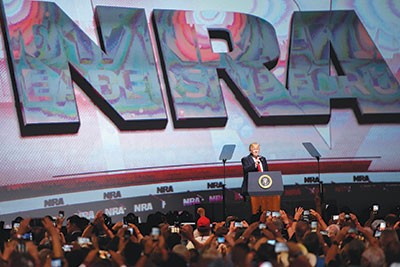
Outgunned no longer: President Trump addressed the annual convention of the newly energized NRA on April 28 in Atlanta. He became the first sitting president since Ronald Reagan to address the event, and pledged to champion Second Amendment-protected rights. Gun-rights advocates would appear to have a firm ally in Trump, who is unlike most previous presidents in living memory. (Photo credit: AP Images)
On another recently opened front in America’s seemingly unending “culture war,” President Trump on February 22rescinded an Obama administration guideline stipulating that public schools should make locker rooms and bathrooms available to transgender students’ gender of choice. The policy, which in effect encouraged schools to allow students to mingle with those of the opposite sex in the intimacy of restrooms and showers, if they self-identified as the opposite sex, was widely reviled by conservatives as but the latest outrage in the cultural Marxists’ fanatical quest to eradicate every last vestige of Christian morality and decency in the commons.
As promised, President Donald Trump lost little time nominating a candidate to fill the longstanding vacancy on the Supreme Court created by the unexpected death of Justice Antonin Scalia last year. Justice Scalia, second only to Clarence Thomas in constitutional fealty, had long been the Supreme Court’s designated defender of original intent, paladin of the people against the many extraconstitutional excesses of the modern federal government. It was Scalia, for example, who wrote the majority opinion in District of Columbia v. Heller, the landmark 2008 case that made legally explicit, for the first time, that the Second Amendment does protect an individual right to keep and bear arms. Though needlessly prolix and full of loopholes (such as the potential exclusion of military-style firearms from protection), Heller has led since its adjudication to the weakening of anti-gun laws in a number of jurisdictions, including notoriously anti-gun Chicago.
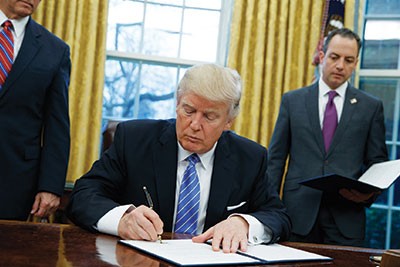
No deal: President Trump signs an executive order on January 23 withdrawing the United States from the Trans-Pacific Partnership (TPP), keeping a campaign promise and extricating the United States from what would have become an Asian-American version of NAFTA. (Photo credit: AP Images)
Both the Left and Right were taken by surprise by the death of Antonin Scalia, and then-President Obama lost no time nominating a lukewarm leftist, Merrick Garland, to replace him. To the fury of the Left and Washington Democrats, the GOP, who controlled the Senate, refused to consider his nomination, since it fell in an election year. Obama’s term in office ended without a replacement for Scalia on the bench.
President-elect Donald Trump pledged to nominate a replacement who would be similar to Scalia and ensure that the Supreme Court would remain tilted in favor of the Right. Trump’s eventual nominee, announced only 12 days into the Trump presidency on January 31, was Neil Gorsuch, an apparent conservative and strongly originalist appellate jurist from the 10th Circuit Court of Appeals. Gorsuch appears to be an ideological clone of Scalia — except for being far more critical than Scalia of the “Chevron doctrine,” the notion that courts should defer to federal regulatory agencies in the interpretation of law and the issuance of regulations. Gorsuch has criticized the Chevron doctrine severely, pointing out that it has encouraged the creation of an entire body of non-legislative laws — federal regulations — that have served to concentrate “federal power in a way that seems more than a little difficult to square with the Constitution of the framers’ design.”
The Gorsuch nomination drew broad praise from many quarters on the Right, including senators Ted Cruz and Mike Lee. It also drew instant vilification and vituperation from the Left. Enraged at this attempt to “steal” a Supreme Court seat, nearly all Democratic senators vowed to oppose Gorsuch on ideological rather than qualificatory grounds, in keeping with partisan precedent set 30 years ago by Democrats during the Robert Bork Supreme Court nomination. No rational human being could deny Gorsuch’s fitness for the position; the American Bar Association, hardly an echo chamber of the political Right, gave Gorsuch its highest rating, “Well Qualified,” in assessing his fitness to serve as Associate Justice on the Supreme Court.
But in the end, Senate Republicans, faced with irrational, nearly unanimous opposition by the Democrats, invoked the “nuclear option,” a procedural recourse eliminating the ability of minority Democrats to filibuster the Gorsuch nomination. Gorsuch was confirmed by a Senate vote on April 7 and took his oath of office three days later. It is to be hoped that his will be as consequential a vote on the side of the Constitution and limited government as was his predecessor’s, but only time will tell.
Donald Trump has been an outspoken proponent of gun rights, and so far he has not disappointed on this critical issue. Only a few weeks after his election, on the last day of February, Trump signed a repeal of an Obama-era rule that would have denied tens of thousands of Social Security recipients the right to own a firearm. The rule empowered the Social Security Administration to notify Social Security recipients with a “representative payee” assigned them because of mental illness that they were no longer permitted to own a firearm. The rule would have placed the burden of proof — that they were not a danger to society — not on the state but on the people so designated, forcing them to prove to the SSA that they were still mentally and emotionally fit. So draconian was this rule that even the likes of the ACLU — a reflexively leftist organization with a history of rationalizing civil liberties violations that fall outside the canon of leftist acceptability — opposed the rule.
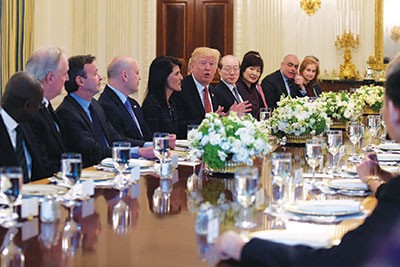
Foreign policy: President Trump and U.S. Ambassador to the UN Nicki Haley have lunch with ambassadors on the UN Security Council. While Trump has been strongly critical of the UN, here he said, “I have long felt the United Nations is an underperformer but has tremendous potential…. I mean, Isee a day whenthere’s a conflict where the United Nations, you get together, and you solve the conflict.” (Photo credit: AP Images)
President Trump also addressed this year’s NRA convention, becoming the first sitting president since Reagan to do so. Trump’s speech, an unapologetic defense of the Second Amendment, was heartening to gun owners everywhere. “I am here to deliver you good news: The eight-year assault on your Second Amendment freedoms has come to a crashing end,” President Trump told the enthusiastic crowd. “I will never, ever infringe on the rights of the people to keep and bear arms.” The NRA gave Candidate Trump a strong endorsement, in recognition of his surprising ideological odyssey from being a vocal supporter of stricter gun laws back in 2000 to becoming that rarest of political animals, a dyed-in-the-wool New Yorker with a concealed-carry permit and an unquestionable enthusiasm for the Second Amendment.
Reining in Regulations
While President Trump’s authority to overturn noxious laws and regulations issued under the direct or indirect auspices of Congress is limited, he has done what he can to begin reining in the behemoth regime of regulations throttling American liberties and economic productivity. On January 30, Trump signed an executive order, “Reducing Regulation and Controlling Regulatory Costs,” which required federal agencies thenceforth to identify for every proposed new regulation two regulations to be eliminated, and which stipulated that, for fiscal year 2017, “the total incremental cost of all new regulations, including repealed regulations, to be finalized this year shall be no greater than zero, unless otherwise required by law or consistent with advice provided in writing by the Director of the Office of Management and Budget.” On February 24, President Trump signed an executive order requiring every federal agency to designate one of its officials as a “Regulatory Reform Officer” tasked with leading an effort to identify and eliminate wasteful, onerous, and otherwise burdensome regulations. While a far cry from what will ultimately be needed to bring government waste and regulatory burden under control, these two executive actions are significant first steps in the right direction that, one hopes, will find congressional support.
On March 13, President Trump struck one additional blow for more bureaucratic efficiency and cost control. In an executive order entitled “Reorganizing the Executive Branch,” Trump directed his subordinates in various executive agencies to consider ways in which their operations can be overhauled and made more cost-effective. “This order is intended to improve the efficiency, effectiveness, and accountability of the executive branch by directing the Director of the Office of Management and Budget (Director) to propose a plan to reorganize governmental functions and eliminate unnecessary agencies …, components of agencies, and agency programs,” the president wrote. The order goes on to stipulate that “within 180 days …, the head of each agency shall submit to the Director a proposed plan to reorgan-ize the agency, if appropriate, in order to improve the efficiency, effectiveness, and accountability of that agency.”
Environmental Reforms
Of the stifling environmental policies of his predecessor, Trump has long been a vocal critic. And here, too, the new president has already proven that his words are not mere greenhouse-gas emissions. On February 28, for example, President Trump moved to undo Obama’s radical “Waters of the United States” (WOTUS) policy directive. In what amounted to a gargantuan power grab calculated to please the radical environmental Left, President Obama’s Environmental Protection Agency (EPA) began reinterpreting references to “waters of the United States” in the Clean Water Act to mean, not merely navigable waters, as established by long regulatory precedent, but virtually any body of water down to ditches, wells, and the smallest ponds. This creative reinterpretation quickly led to EPA oversight over almost any body of water, however small, temporary, or artificial, as a potential wetland. As President Trump’s order noted, the EPA, never known for erring on the side of moderation, soon began perpetrating grotesque miscarriages of justice in the name of the new policy, such as a Wyoming rancher fined $37,000 a day for digging a small watering hole for his cattle. “The EPA’s regulators were putting people out of jobs by the hundreds of thousands, and regulations and permits started treating our wonderful small farmers and small businesses as if they were a major industrial polluter,” the president wrote. “With today’s executive order, I’m directing the EPA to take action, paving the way for the elimination of this very destructive and horrible rule.”
Exactly four weeks after the WOTUS directive, President Trump turned his attention to President Obama’s outrageous exploitation of global-warming hysteria. In an executive order entitled “Promoting Energy Independence and Economic Growth,” President Trump undid with the stroke of a pen a wide range of climate-related edicts issued by President Obama in compliance with new UN-mandated global climate standards. Revoked and rescinded were:
• Executive Order 13653 of November 1, 2013 (Preparing the United States for the Impacts of Climate Change);
• The Presidential Memorandum of June 25, 2013 (Power Sector Carbon Pollution Standards);
• The Presidential Memorandum of November 3, 2015 (Mitigating Impacts on Natural Resources from Development and Encouraging Related Private Investment);
• The Presidential Memorandum of September 21, 2016 (Climate Change and National Security);
• The Report of the Executive Office of the President of June 2013 (The President’s Climate Action Plan); and
• The Report of the Executive Office of the President of March 2014 (Climate Action Plan Strategy to Reduce Methane Emissions).
Moreover, the order directed federal agencies to “immediately review existing regulations that potentially burden the development or use of domestically produced energy resources and appropriately suspend, revise, or rescind those that unduly burden the development of domestic energy resources beyond the degree necessary to protect the public interest or otherwise comply with the law.” This wide-ranging and detailed executive order does not withdraw the United States from the global climate-change regime foisted on the United States by the Obama administration in accordance with the “Paris Agreement,” a United Nations agreement that President Obama signed and put into effect by executive fiat, ignoring the advice and consent of the Senate, as mandated by the Constitution. Nor does it reverse the EPA’s absurd finding that CO2 is a pollutant. But it is still a huge step in the right direction. At the signing of his order, Trump told those in attendance, including coal miners whose livelihoods had been targeted for so long by President Obama’s environmentalist myrmidons: “Together we are going to start a new energy revolution. I am taking historic steps to lift restrictions on American energy, to reverse government intrusion and to cancel job-killing regulations.”

New lease on life: Coal mines such as this one in Wyoming are resuming coal leasing following President Trump’s lifting of a federal coal lease moratorium in late March, a sweeping restriction imposed on the coal industry in 2016 by Barack Obama. (Photo credit: AP Images)
On April 26, President Trump issued an executive order mandating that the Department of the Interior review two dozen national monuments created by presidents Clinton, Bush, and Obama. This action was greeted with particular enthusiasm by Utah Republicans still chafing over President Obama’s lame-duck land grab designating an area larger than the state of Rhode Island as the new Bear’s Ears National Monument (as well as the new Gold Butte National Monument in Nevada). Utah is no stranger to this type of treatment; in the waning weeks of the Clinton administration, President Clinton, knowing Democrats would pay no political price in rock-ribbed Republican Utah, did the same for a vast wilderness area in southern Utah now known as the Grand Staircase-Escalante National Monument. While Trump’s order may or may not lead to an unprecedented reversal of some of these land grabs, the mere fact that President Trump is calling into question such executive abuses (carried out under the dubious authority of the Antiquities Act) is heartening for those of us who would like to see authority over western lands restored to the people who live there.
That same week, President Trump issued an executive order (certain to be challenged in court) that reversed the Obama administration’s ban on further Arctic oil drilling and also set in motion a comprehensive review of the many regulatory barriers to offshore oil and gas drilling along the Atlantic Coast. This order has been received with particular horror by radical environmentalists, since it would entail reversing decades of bureaucratic nullification of energy exploration on the Atlantic continental shelf. It is worth noting that Canada’s Hibernia oilfield off the coast of Newfoundland has proven to be an economic boon to Atlantic Canada, with more drilling platforms planned. And despite dire warnings of environmental apocalypse, Atlantic Canada’s abundant marine life is as fecund as ever.
President Trump has also seen more than a few setbacks as a result of the fevered opposition of his many enemies. As the media has delighted in informing us, his promises to repeal and replace Obama-Care have so far been stymied by internal party divisions, although a new version of the American Health Care Act (AHCA) being crafted in the House appears more likely to pass and go to the Senate. The bill does not abolish many of the noxious mandates imposed by ObamaCare, but allegedly is enough of a first step in the right direction to win approval by a number of members of the House Freedom Caucus, whose opposition deep-sixed an earlier version that was called “ObamaCare Lite” by critics and supported by Trump.
Trump’s awaited tax cuts have yet to gain traction, although the administration is confident tax reforms will be forthcoming later this year. His much-ballyhooed border wall is in acute danger of falling victim to the congressional budget knife, with many of his GOP colleagues balking at giving support to the polarizing measure. But overall, those of us who have waited long for a president genuinely committed to rolling back the size, cost, and power of the federal government have so far seen ample grounds for optimism by President Trump’s actions — with one notable and unfortunate exception: foreign policy.
Foreign Policy
Candidate Trump campaigned on promises to scale back American involvement in Middle Eastern broils, and in the Syrian Civil War in particular, but President Trump has gone back on his word in spectacular fashion. In early March, President Trump deployed a certain number of Marines and Army Rangers to Syria to assist the Syrian resistance in the assault on Raqqa, the ISIS capital. On April 4, a chemical weapons attack against Syrian civilians in the town of Khan Shaykhun resulted in dozens of casualties, including many children, and generated the usual international condemnation and calls for the repellent Assad regime to be held accountable. Three days later, the Trump administration launched a massive missile attack against Syria’s Shayrat Airbase. A total of 59 ship-launched Tomahawk cruise missiles pounded the base where, according to intelligence reports, the gas attack had originated. In the wake of the attack, U.S. and world leaders, in a departure from the usual withering criticism, lavished President Trump with praise for acting presidential and seizing anew the reins of international leadership — meaning, of course, the willingness to act as the world’s policeman. This was precisely the type of thing that Trump’s support base opposed. In Trump they believed they had finally found a president who would mind America’s business and not the rest of the world’s. But President Trump appears no less willing than his predecessors to use America’s military might to punish foul dictators wreaking havoc in remote corners of the world, but who pose no threat to us.

Strike one: Syria’s Shayrat Airbase after the April 7 missile strike ordered by President Trump in response to the chemical weapon attack allegedly carried out by the Assad government against Syrian civilians days earlier. During his campaign, Trump criticized President Obama’s involvement in the Syrian Civil War. (Photo credit: AP Images)
In a similar vein, President Trump is showing every evidence of a willingness to go to war to prevent North Korea from obtaining ICBMs. In this issue, perhaps, the correct course of action will prove more nuanced, inasmuch as a North Korea capable of subjecting the United States to nuclear blackmail is not to be contemplated. But it is already apparent that President Trump is no more likely to restore America’s military to a primarily defensive role than was President Obama or any of his other recent predecessors.
It is also apparent that, despite his anti-globalist stance, Trump is also willing to use the United Nations to solve global problems. At an April 24 White House meeting with ambassadors from UN Security Council countries, Trump said, “The Council must be prepared to impose additional and stronger sanctions on North Korean nuclear and ballistic missile programs.” He added: “The United Nations is an underperformer, but it has huge potential.”
The Swamp Fights Back
Besides matters of policy, the first 100 days of the Trump administration will doubtless be remembered by the many scandals, most of them manufactured by the establishment media, that have distracted the president and — as intended — distracted him to some extent from carrying out his ambitious agenda. These various hobgoblins and chimeras include, but are not limited to, alleged Russian interference in the elections, allegedly inappropriate contacts between Trump campaign officials and Russian representatives, Trump’s reluctance to make public his tax returns, alleged conflicts of interest involving Trump’s many businesses, Trump’s frequent use of Mar-a-Lago instead of the White House for official meetings, and Trump’s many unfiltered Tweets.
Of particular note were Trump’s sensational claims, Tweeted on March 4, that accused the Obama administration of wiretapping him during his campaign. While the claim of “wiretapping” may turn out to be technically inaccurate, it was soon revealed that, indeed, a number of people involved in the Trump campaign were subject to surveillance by the federal government during contact with foreign nationals.
While it was the foreign nationals and not the Trump people who were the targets of the known surveillance, it turned out that zealous Obama administration officials, in particular National Security Advisor Susan Rice, “unmasked” the names of Trump officials surveilled and disseminated them widely within the government. Normally, the names of American citizens are redacted from reports on such surveillance, but Rice and others apparently decided that the rules did not apply to the Trump campaign. Someone then leaked much of the information to the news media, resulting in widespread reporting that the Trump campaign had been compromised by contact with hostile foreign agents, especially Russia. That a president would use America’s vast security apparatus to gather intelligence on a political rival and then use that intelligence to sow scandal and chaos is reprehensible and downright terrifying. That the intelligence community would be so willingly complicit in such an outrage speaks volumes about the degree to which it actually serves the American people rather than the Washington establishment.
President Trump’s promises to “drain the swamp” and bring down the elite establishment have generated a ferocious backlash, with leftist politicians aligning with entrenched judicial and national security elites to defend their enormous powers. It is possible that Trump, recognizing the potency of the national security establishment after months of manufactured scandal and innuendo, decided to attack Syria as a sop to Cerberus. Indeed, the attacks on Trump’s alleged Russian ties have abated considerably since the Syrian missile strike. But on other fronts, an entrenched federal judiciary remains as determined as ever to thwart the Trump agenda. By now, President Trump is surely aware that the judicial system is honeycombed with hard-core leftist subversives, a state of affairs that one Supreme Court appointment will do little to mitigate.
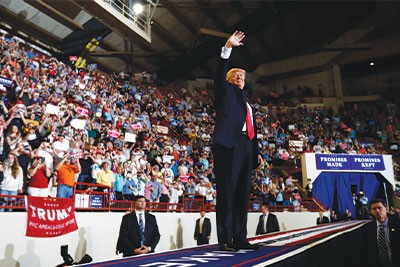
The 100th day: President Trump arrives at a speech in Harrisburg, Pennsylvania, held on the same day as the annual White House Correspondents’ Association dinner in Washington, D.C. — an event the president snubbed in order to spend time with people in one of the states that helped to elect him. (Photo credit: AP Images)
In sum, President Trump deserves high marks on constitutional, regulatory, and fiscal grounds, so far. His foreign policy has been generally right-headed in regard to trade and border security, but decidedly wrong-headed on Syria. His actions in reversing Obama-era environmental abuses, in withdrawing from the TPP, and in beginning the process of making federal agencies more cost-effective are particularly noteworthy, and are unprecedented in scope and audacity for any president in living memory. President Trump is the first president in this author’s more than 50 years to take steps to reduce the size and cost of government.
However, Trump’s bitter enemies, which include an ex-president, hundreds of determined Democratic lawmakers, and thousands of violent leftist radicals taking their opposition to the streets, have taken a toll on him. We expect them to continue their street-fighter tactics.
Donald Trump, despite his laudable constitutional allegiances, is at heart a populist more than a constitutionalist, and is unlikely to become a modern Jefferson or Madison. His populist leanings will doubtless lead him into error. But if what we have seen during his first 100 days is any bellwether, his successes on behalf of less government and a more robust Constitution may end up outweighing his defects.

